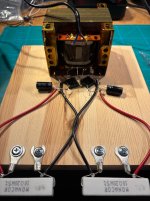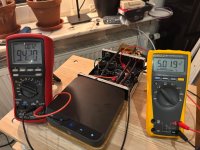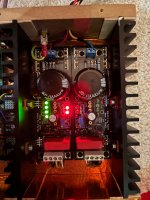Yea I can just grab 0 v out, didn’t think so far. Went out now but I would guess between 10-11. VAC in was like 9,5ish. Donut is 8,4 v 3 A speced (plus two other small windings). To much? It’s for a Bluesound Nano with USB C in. It has a 2000 mA wall wart but I doubt it takes more than 500. Testing with 4R7
I did some quick inspections before I start building it in to chassie etc.
Channel A (blue) is the wall wart that it shipped with and B is the L-adapter. It was crude unshielded and not bw-limited measurements with ordinary probe hooks probably catching all kids of areal RF. Both scales 200 mV.

Then a 200 kHz bw-limited compare to exclude some areal RF. Note that A (wall wart) is still on 200 mV scale, but B (L-adapter) is on a 10 mV scale. I think it will do some good 🙂

Channel A (blue) is the wall wart that it shipped with and B is the L-adapter. It was crude unshielded and not bw-limited measurements with ordinary probe hooks probably catching all kids of areal RF. Both scales 200 mV.
Then a 200 kHz bw-limited compare to exclude some areal RF. Note that A (wall wart) is still on 200 mV scale, but B (L-adapter) is on a 10 mV scale. I think it will do some good 🙂
Yes, I think so. I mounted it on a 6 mm aluminum plate that will also be part of an extra foundation for the Bluesound Nano. The Nano has a good base sound that is a little different than my Node 2i but it has a higher noice level than the 2i’s which has built in higher quality smps, so I suspect the wall wart to USB C is incriminated in that.
With this donut that I found in a drawer it has a volt or two more headroom then it needs but the fet didn’t even go lukewarm so I keep it like that for now. It also has a small 2x14v 1A winding that can come handy for remote 12 v use, since this app is always on.
It was a pita to find out how to measure the wall wart but I found an usb to dc plug cable in another drawer and a dc female chassis plug in a third that I could solder the dummy resistor to. And the L-adapter even harder as soon as I have soldered the USB C to it.
I will see if I can rf shield the dummy loads somewhat today and make some more measurements. Is it ok to solder the dummy directly to an rg58 with a bnc in the other end and plug directly to the scope you think?
With this donut that I found in a drawer it has a volt or two more headroom then it needs but the fet didn’t even go lukewarm so I keep it like that for now. It also has a small 2x14v 1A winding that can come handy for remote 12 v use, since this app is always on.
It was a pita to find out how to measure the wall wart but I found an usb to dc plug cable in another drawer and a dc female chassis plug in a third that I could solder the dummy resistor to. And the L-adapter even harder as soon as I have soldered the USB C to it.
I will see if I can rf shield the dummy loads somewhat today and make some more measurements. Is it ok to solder the dummy directly to an rg58 with a bnc in the other end and plug directly to the scope you think?
Last edited:
First a baseline measurement of the wall wart. Its switching frequency is 30 (,55) kHz and its peak to peak ripple is 180 mV. Nasty stuff this. Now it can co to the bin.

Then the L-adapter with the same 1 A load. I didn't rf shield it but I grounded the aluminium plate and used a spring hook to narrow the loop somewhat on an Agilent 10073 C

About 500 uV without bw limiting the scope.

Completely flat line with 200 kHz bw limit. Scope measured around 50 uV, probably including my shaky hands when steering the computer mouse while holding the probe, Ok, good enough to box up!

About 500 uV without bw limiting the scope.
Completely flat line with 200 kHz bw limit. Scope measured around 50 uV, probably including my shaky hands when steering the computer mouse while holding the probe, Ok, good enough to box up!
Yes. It is the last bit amazoned china USB C female with short leads that drops most. I ordered a few just to be able to test with the male soldered. I used gauge 18 up to that one. USB, afaik, has a spec on 4,75 to 5,25 so I guess I just dial it to 5,05-5,1 on the L-pad and test. Hard to measure at the end with a plastic commercial thingy connected with USB C.
I came to think there is two things I want to be constantly on in the rack. It is the streamer and an USW Flex Mini Ethernet switch. I can give that one some love as well with another L-adapter. It craves up to 500 mA 5 VDC USB C that one to, about the same as the streamer. Two secondary windings and two L-adapters. It’s like I planned it 🙂
I came to think there is two things I want to be constantly on in the rack. It is the streamer and an USW Flex Mini Ethernet switch. I can give that one some love as well with another L-adapter. It craves up to 500 mA 5 VDC USB C that one to, about the same as the streamer. Two secondary windings and two L-adapters. It’s like I planned it 🙂
Benching on site. Took L-Adapter Vout up to 5,075 after some warmup. Plenty of headroom from 7 vac secondary.
Unfortunately my SSLV powered X-over does not lit up so I can’t enjoy music tonight. Will check it out tomorrow, plan was to let thing idle overnight and check the endurance of things, like a little rehearsal. Waiting for material for the PSU build anyway.
Unfortunately my SSLV powered X-over does not lit up so I can’t enjoy music tonight. Will check it out tomorrow, plan was to let thing idle overnight and check the endurance of things, like a little rehearsal. Waiting for material for the PSU build anyway.
Attachments
- Home
- Amplifiers
- Power Supplies
- L-Adapter


